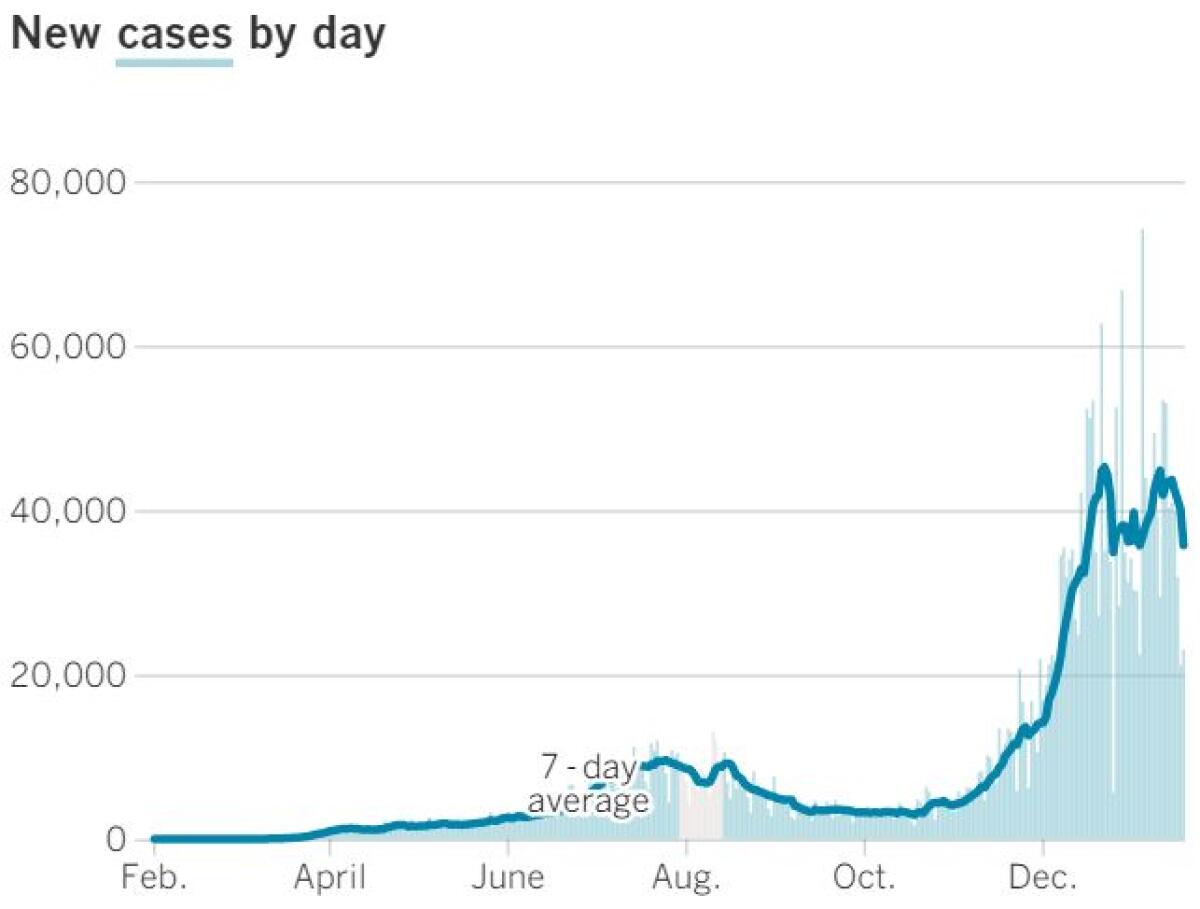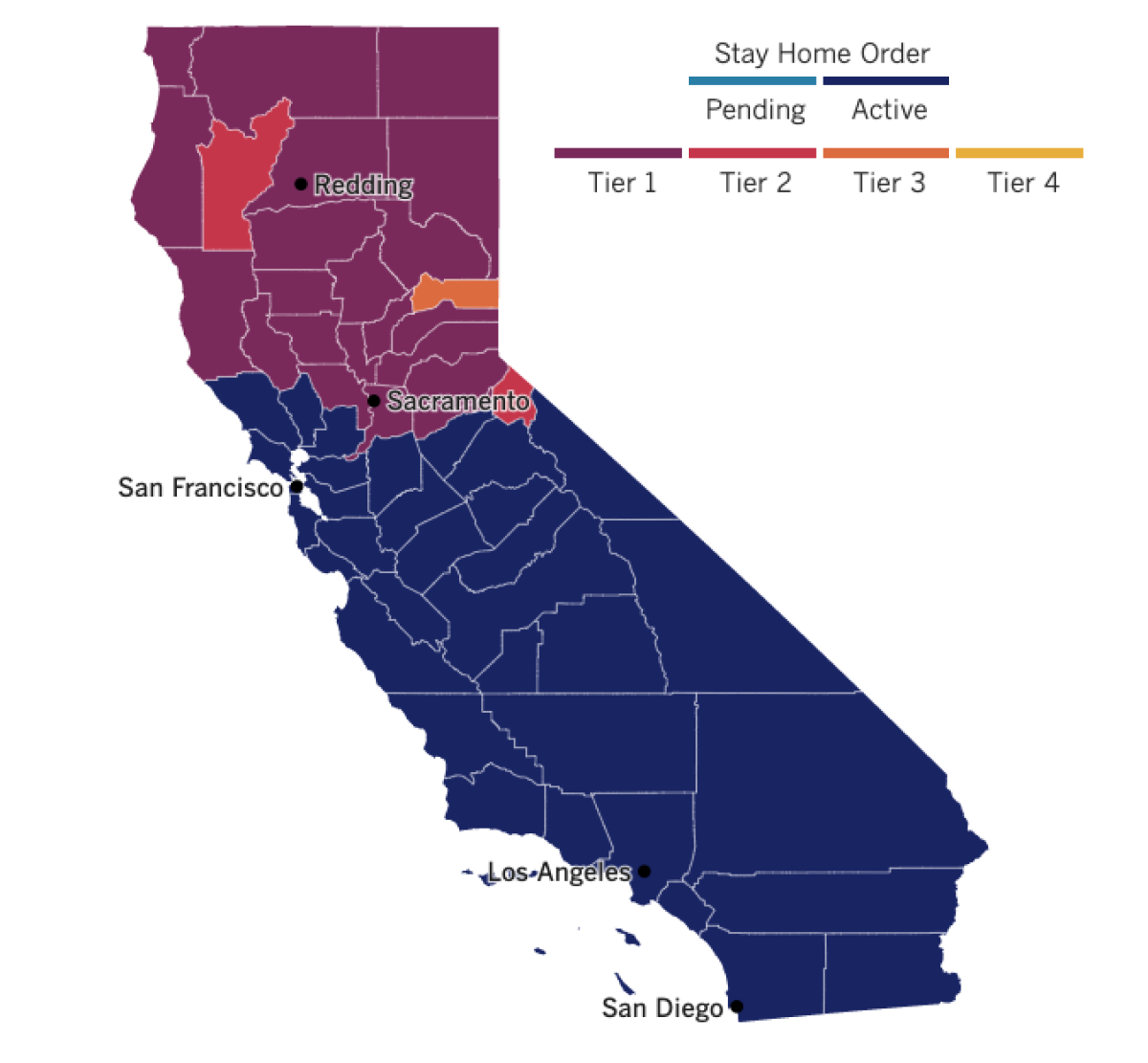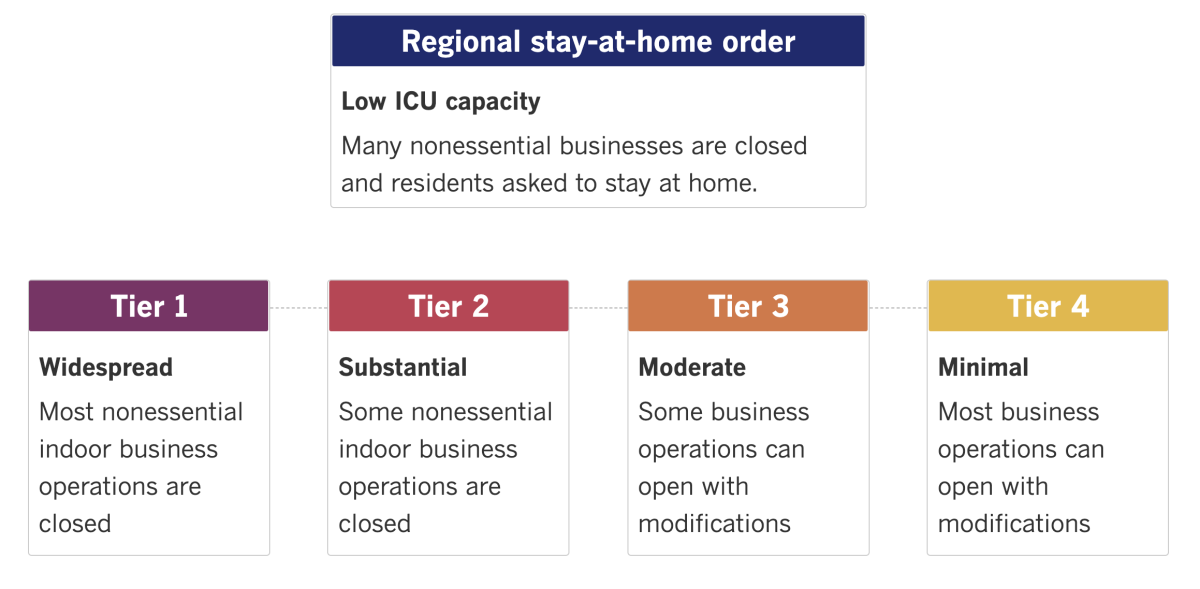Coronavirus Today: Have we finally plateaued?
Good evening. I’m Amina Khan, and it’s Tuesday, Jan. 19. Here’s what’s happening with the coronavirus in California and beyond.
As we start this new week with eyes turned toward Washington, the upcoming inauguration and all the change that is sure to follow, I want to take a moment to consider two facts about the Southland’s pandemic situation.
First: So many people have died in Los Angeles County that officials have temporarily suspended air-quality regulations that put limits on cremations. The current death rate is “more than double that of pre-pandemic years, leading to hospitals, funeral homes and crematoriums exceeding capacity, without the ability to process the backlog,” the South Coast Air Quality Management District said Sunday.
Second: Among L.A. County Fire Department staffers, even having received a single dose of a two-dose COVID-19 vaccine regimen seems to have driven down infection rates. Since vaccinations started in late December, positive coronavirus test results have plummeted from 18% to less than 6%, officials said — even as new cases continued to surge through L.A. “This is the first time in the entire pandemic that our data diverged from that of the county,” said Dr. Clayton Kazan, the county Fire Department’s medical director.
These two facts offer a portrait of the Janus-faced situation in Southern California: the deadly consequences of holiday gatherings literally affecting the air we breathe, and small signs of hope that vaccines will allow life to return to something akin to normal.
But the state’s vaccine rollout hasn’t exactly been smooth. Many Californians, including some front-line workers, still feel hesitant about being vaccinated — some firefighters apparently among them. (About 40% of Los Angeles city firefighters had yet to show up to get the priority shots as of Friday, along with roughly a quarter of county firefighters as of Monday.) At the same time, many of those who desperately want a vaccine and are eligible to get it still haven’t been able to do so.
Gov. Gavin Newsom, under pressure to accelerate vaccinations, announced last week that people ages 65 and older would now be eligible to receive a vaccine. That inspired a chaotic scramble, as elderly Californians tried to sign up on crashing websites or showed up at pharmacies where they were told there were no shots for them yet. It soon became clear in many counties that vaccines would be in short supply for a while, in part because there were so many medical workers and first responders who had yet to get their shots.
Take Marcy Rothenberg, a 70-year-old who was buoyed by Newsom’s announcement, only to learn that L.A. County was not offering vaccine to her age group. She was turned away from her scheduled appointment at a Ralphs supermarket. “I always had the sense that government, for all its flaws, would be there to provide these services, but it’s as if nothing is working,” she said. “It’s sad that they seem to be scrambling instead of coordinating.”
It’s a situation that has frustrated many, including columnist Steve Lopez, who managed to sign up for a vaccine appointment in Alaska but not at home in California. “Why do seniors, who have been hit hardest by the virus, have to wait for reluctant firefighters to do the right thing in the interest of public health?” he wondered. “Aren’t public health and safety their mandate?”
In Los Angeles County at least, help may be on the horizon: In an executive order issued Monday, Hilda Solis, who chairs the Board of Supervisors, directed health officials to make COVID-19 vaccination appointments available to residents 65 and older starting Thursday.
“The COVID-19 vaccine rollout has been an enormous undertaking, especially during an unprecedented surge where cases, hospitalizations, and deaths continue to skyrocket,” she said. “However, if we are to ever get out of this dark winter, it is critical that we make headway vaccinating people 65 years of age and older as soon as possible.”
The rollout, it seems, may be speeding up — and my colleagues are here with some information on what to expect Thursday.
By the numbers
California cases, deaths and vaccinations as of 5:54 p.m. PST Tuesday:

Track the latest numbers and how they break down in California with our graphics.
Across California
It’s official: California surpassed 3 million coronavirus cases Tuesday — an unwelcome milestone that arrives amid signs that the pandemic may have finally plateaued. Clearing the 3-million mark means that roughly 1 out of every 13 Californians has been infected at some point during the pandemic — a stark reminder of just how widely the coronavirus has spread through the nation’s most populous state, my colleagues Luke Money and Rong-Gong Lin II write.
Keep in mind, it took roughly 10 months for the state to reach 1 million confirmed cases in mid-November. The remaining 2 million cases were logged in just two months.
“The slope and scope of the pandemic’s latest wave makes California’s summertime surge look like a speed bump,” Money and Lin write. Back then, the highest number of new daily infections topped out around 13,000. But over the last week, the state has averaged nearly 36,000 new cases per day. That’s not even the pandemic’s peak — not too long ago, California was seeing nearly 45,000 cases per day.

In Los Angeles County, which logged its 1 millionth case on Saturday, health officials for the first time confirmed the presence of the new and more contagious coronavirus variant that originated in the United Kingdom. The variant, B.1.1.7, had already been detected in San Diego and San Bernardino counties as well as in 14 other U.S. states, according to the Centers for Disease Control and Prevention. While it is not believed to make people sicker or increase their risk of death, it does appear to spread more easily — triggering fears that it could stymie efforts to bring the pandemic under control if it becomes dominant in the region.
“The presence of the U.K. variant in Los Angeles County is troubling, as our healthcare system is already severely strained with more than 7,500 people currently hospitalized,” said Barbara Ferrer, the county public health director.
To add to their worries, another new strain is also popping up more frequently across the state. Researchers have identified it in a dozen counties and linked it to several large outbreaks in Santa Clara County. So far, it’s not clear whether the variant is highly contagious or is simply being identified more frequently as lab work becomes more sophisticated, state public health officials said.
“This virus continues to mutate and adapt, and we cannot let down our guard,” said Dr. Sara Cody, Santa Clara County health officer.
In an effort to speed up the reopening of in-person classes for students, Los Angeles schools Supt. Austin Beutner said Monday that schools should be used as COVID-19 vaccination centers, adding that his 900 campuses were “ready to go.” It could also mean getting doses to teachers more quickly; so far, public health officials estimate that vaccines will be available for teachers sometime in February, so long as the county has enough on hand.
“So many communities in the Greater Los Angeles area lack access to healthcare,” Beutner told The Times. “And if we don’t bring healthcare to people, they’re going to continue to lack access to healthcare, including vaccinations. And one of the virtues of schools being located in every neighborhood, every community in the areas we serve, is that we can bring access to where people are.”
Students aren’t likely to be vaccinated any time soon; among other things, the shots have not yet been determined to be safe for children.
Meanwhile, UC San Diego is reporting a big surge in coronavirus infections among students who have returned to campus after the holiday break. Officials said that 245 of its students have tested positive since winter quarter started Jan. 4 — the sort of surge that the university managed to avoid last fall through a major testing and education campaign called “Return to Learn.”
Among the on-campus students who tested positive, 85% had gone home for the holiday and probably became infected there, said Dr. Robert T. “Chip” Schooley, a professor of medicine who is helping run Return to Learn. “Going home during a raging pandemic is a dangerous thing.”


See the latest on California’s coronavirus closures and reopenings, and the metrics that inform them, with our tracker.
Consider subscribing to the Los Angeles Times
Your support helps us deliver the news that matters most. Become a subscriber.
Around the nation and the world
President-elect Joe Biden plans to issue a host of executive orders in his first days in office that would reverse or revise contentious Trump administration policies related to the COVID-19 pandemic. Biden has also laid out a vaccination plan that throws the weight of the federal government behind the effort, my colleagues report.
The day after he is sworn in, Biden plans to order actions aimed at expanding virus testing and speeding up the reopening of schools and businesses whose operations have been restricted, my colleague David S. Cloud writes.
In a speech five days before his inauguration, Biden described an ambitious initiative that includes funding for community vaccination centers and other ways to expand access to shots, such as invoking the Defense Production Act to increase manufacturing of vaccines and related supplies.
This all-out federal effort stands in sharp contrast to the mostly hands-off approach of the Trump administration, which left it to states and localities to decide how to allocate and administer vaccines, my colleagues Janet Hook and Noam N. Levey write. “The vaccine rollout in the United States has been a dismal failure so far,” Biden said. “You have my word: We will manage the hell out of this operation.”
Iran’s COVID-19 death toll is approaching 60,000 and its total caseload has surpassed 1.3 million, making it the Middle East’s worst-hit country and the 16th-most afflicted nation in the world, my colleague Nabih Bulos writes. But that did not stop Iran’s Supreme Leader Ayatollah Ali Khamenei from banning Western-made vaccines earlier this month, including those developed in the U.S. “Sometimes they want to test the vaccine on other nations,” Khamenei warned of the U.S. in particular.
Iran’s Red Crescent canceled an order for 150,000 doses of the Pfizer-BioNTech vaccine, saying it would import alternatives from non-Western countries. Other officials said Iran would continue developing a homegrown vaccine.
The move sparked outrage from a group of opposition politicians and activists who said decisions about vaccine quality “should be the sole domain of the country’s experts,” according to an open letter addressed to government authorities.
A panel of experts commissioned by the World Health Organization has criticized China and other nations for not moving more quickly to stem the initial coronavirus outbreak. The panel also questioned whether the United Nations’ public health agency ought to have labeled it a pandemic sooner than it did on March 11, weeks after the virus had started causing explosive outbreaks on several continents.
“What is clear to the panel is that public health measures could have been applied more forcefully by local and national health authorities in China in January,” shortly after the coronavirus began sickening clusters of people, the report said.
A Chinese official disputed the conclusion that China had acted too slowly, pointing out that the city of Wuhan, where the first human cases were identified, was locked down within three weeks of the start of the outbreak.
Former Liberian President Ellen Johnson Sirleaf, one of the panel’s leaders, said it was up to countries to decide whether to overhaul the WHO to give it more authority and funding to eradicate outbreaks. “The bottom line is WHO has no powers to enforce anything,” she said. “All it can do is ask to be invited in. ... This clearly isn’t working.”
Your questions answered
Today’s question comes from readers who want to know: Can you be infected with the same strain of coronavirus more than once?
We’ve discussed the problem of reinfection earlier, in the context of whether you should still mask up if you’ve recovered from COVID-19 or if you’re near someone who has. (Spoiler alert: YES to both.)
What I may not have made clear at the time was this: Not only can you suffer a second coronavirus infection if you’re exposed to a different strain of the virus, you can potentially be reinfected by the exact same one, according to Dr. Stuart Ray, an infectious disease specialist at the Johns Hopkins University School of Medicine.
For more, I reached out to Dr. Charles Chiu, a virologist and infectious diseases physician-scientist at UC San Francisco.
“Yes, you can certainly get infected by the same strain more than once,” Chiu said. That could occur “if you did not generate effective neutralizing antibodies in response to the initial infection, or if those antibodies waned over time,” he said.
So far, reinfection of any kind is thought to be a rare occurrence, he said. But due to testing limitations, it’s impossible to say how many times a single strain has caused two infections in the same person, he and Ray said.
“If the same strain is detected during a presumptive reinfection, we cannot rule out the possibility that a person had been infected with that strain initially and was chronically shedding the virus over months, instead of being reinfected by the same strain,” Chiu said.
In other words, testing can confirm a second infection only if the virus’ genetic code looks noticeably different the second time around.
All of this is to say, once again, that it’s important to mask up to protect yourself and other people, whether or not you’ve been through a bout of COVID-19.
We want to hear from you. Email us your coronavirus questions, and we’ll do our best to answer them.
Resources
Practice social distancing using these tips, and wear a mask. Here’s how to do it right.
Watch for symptoms such as fever, cough, shortness of breath, chills, shaking with chills, muscle pain, headache, sore throat and loss of taste or smell. Here’s what to look for and when.
Need to get tested? Here’s where you can in L.A. County and around California.
Americans are hurting in many ways. We have advice for helping kids cope, resources for people experiencing domestic abuse and a newsletter to help you make ends meet.
For our most up-to-date coverage, visit our homepage and our Health section, get our breaking news alerts, and follow us on Twitter and Instagram.




